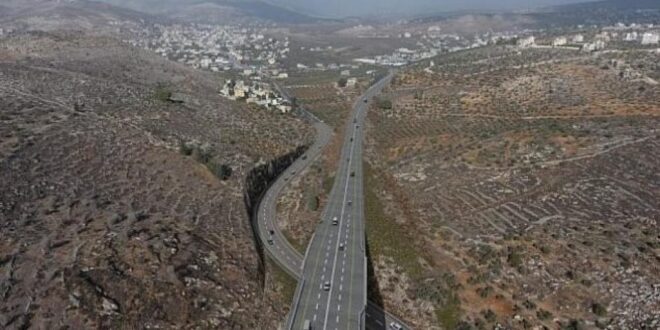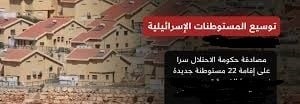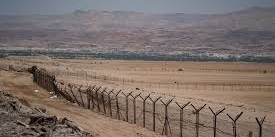By: Madeeha Al-A’raj
The National Bureau for Defending the Land and Resisting Settlements stated in its latest weekly report that Israeli Finance Minister, Smotrich and Minister of Transportation, Regev have agreed to allocate billions of shekels in order to develop roads and infrastructure of settlements in the West Bank and occupied Jerusalem, they included them in the general budget within the framework of the annexation plan, as the Israeli government allocated about NIS 4 billion fcor that, and NIS 160 million for infrastructure projects and road development in settlements.
The budgets include allocating half a billion shekels to widen the settlement road from the Junction of the “Ariel” settlement to the “Taffouh” settlement in Salfit Governorate, allocating NIS 150 million to develop the road network near the “Alfi Menashe” settlement, south of Qalqilya, and allocating a budget of NIS 200 million to build a bypass road near Fondoq town, while a budget of NIS 366 million will be allocated to modernize and widen the road leading to the ‘Beit El’ settlement.
A budget of NIS 136 million will be allocated to expand the road leading to the ‘Beit El’ settlement, and a budget of NIS 2 billion will be allocated to develop and expand settlement Road n. 60. According to the understandings, an amount of NIS 156 million was also allocated for the development of an junction and main roads near Al-Isawiya for the benefit of the settlers, and NIS 80 million for the expansion of the eastern bypass road in Jerusalem, which serves the settlements in the Jerusalem area until Bethlehem and Hebron, in addition to allocating a budget of NIS 300 million for the construction of a settlement road linking a settlement. Majron in the Qalandia Crossing.
At the same time, the occupation authorities will start next month digging the ring road, east of Jerusalem, which the occupation calls the ‘fabric of life road’ or ‘the road to sovereignty’ because it paves the way for the annexation of the ‘Ma’ale Adumim’ settlement to Jerusalem and paves the way for the implementation of the ‘E1’ settlement plan.
The excavation works come as a mean to paving the street, which aims to completely close the northern entrance to the town of Al-Eizariya, and divert movement towards the north of the town towards Jabal Al-Baba and the town of Al-Zaeem, to link the southern West Bank area with the Jordan Valley area and the city of Jericho on the eastern side of the West Bank.
The road aims to allow Palestinians to move from the south to the north without the need to travel on the roads designated for settlers in these areas. The paving of the road is an apartheid road between the Israelis and the Palestinians, and the road is of great importance for the annexation of the ‘Ma’ale Adumim’ bloc to Israel and for advancing the construction plan ‘E1’ located at the eastern entrance to Jerusalem, and moving it near the east of the ‘Kfar Adumim’ settlement, and thus will allow the continuation of movement without security checks and checkpoints by settlers from the ‘Ma’ale Adumim’ bloc to Jerusalem.
These bypass roads are considered one of the occupation’s tools used in implementing the policy of imposing facts on the ground and shaping the geography of the West Bank.
The National Bureau had referred in previous reports to the most important and dangerous of these bypass roads, such as the Hawara bypass road ‘Za’tara junction’, the Arroub bypass road, the Qalandia tunnel, the western Laban bypass road, the AnNabi Elias bypass road, the eastern ring road / Jerusalem, the 60 bypass road, the eastern Gush Etzion road – the Dead Sea, and others.
Moreover, the Israeli District Committee pushed plans to build 2969 settlement units in the settlements of French Hill, Pisgat Ze’ev and Givat Shaked within a series of successive settlement plans, which would consolidate Israeli control over more lands in East Jerusalem, and control its separation from the West Bank in all directions.
It also decided to accept all the documents of the amended plan and approved each plan for submission for public review and objections. The so-called amended plan confiscates thousands of dunums in the center Jerusalem, south, and east of the city, and it entails threatening the population centers present in the targeted areas. In addition it set a discussion session on the objections to the Wadi Al-Jawz Business Center project ‘Silicon Valley’ on May 2, which is an advanced step towards its final approval, noting that the local planning committee rejected the objections and recommended approval of the plan last March.
List of Israeli Assaults over the Last Week Documented by the National Bureau:
Jerusalem:
- Attacking a solidarity stand by the residents of the Sheikh Jarrah Neighborhood in occupied Jerusalem that condemns the policy of settlement and displacement.
- Storming Al-Rahma Gate pray area to the eastern side of Al-Aqsa Mosque.
- Giving a week period of time to the family of Hajja Fatima Salem to demolish her house in the Sheikh Jarrah Neighborhood, under the pretext that it was Jewish property before 1948.
Hebron:
- Attacking citizens and shepherds, and threw stones at them in the village of Uml-Khair and the ruins of Thala and Kharouba in the Yatta town.
- Storming land in the Wadi Kharsa area of Beit Awa, and demolished about five shops located in the market known as Al-Ataq “Al-Raish” market in the Old Hisba area to build settlement units.
- Spoiling crops east of Yatta.
- Raising Israeli flags on the Ibrahimi Mosque and in the city of Hebron during times other than the Jewish holidays, which would suggest Judaizing messages to impose a de facto in the Ibrahimi Mosque.
Nablus:
- Attacking citizens’ vehicles with stones on the road between Ramallah and Nablus, near the town of Turmusaya, which led to the injury of a number of citizens.
- Burning a house located between the towns of Qusra and Jalud, south of Nablus, after an attack carried out by settlers on the homes of citizens on the outskirts of the town of Qusra.
- Attacking citizens’ vehicles, homes, and greenhouses, near the Ein Shibli village, and cutting down 30 perennial olive trees.
Jenin:
- Injuring the child, Moh’d Marwan Talal, 12 by the occupation live bullets near the Al-Arqa village, south of Jenin.
- Storming the evacuated ‘Homesh’ settlement near the town of Silat-Dhahr, and performed Talmudic prayers at the site accompanied by the Minister of Finance of the extremist Israeli occupation government, Bezalel Smotrich, and Knesset members.
Qalqlia:
- Confiscating land in the village of Siniriya, with an area of 52 dunums, and agricultural land with an area of 300 square meters, in the town of Azzun, east of Qalqilya, planted with perennial olive trees.
- Seizing a bulldozer belonging to a citizen while it was working on reclaiming agricultural lands on the Nabi Elias’ road.
Jordan Valley:
- Continuing to close most of the roads leading to communities and agricultural lands east of road 60 in the Jordan Valley, which impedes the progress of daily life, as they are vital passages for farmers to reach their lands.
- Notifications of demolition of residential facilities in Khirbet Humsa al-Tahta
- Issuing a notice of the final demolition of residential facilities in the Ain Al-Hilweh area, and further notifications of the demolition of a house under construction in the village of Al-Nuwaimeh, an area of about 120 square meters, under the pretext of not having a permit.
- Injuring 4 citizens after an attack by settlers in Khirbet al-Sakot.
- Raiding the Al-Deir Springs area in the northern Jordan Valley, east of the village of Ein-Beda.
 المكتب الوطني للدفاع عن الارض ومقاومة الاستيطان منظمة التحرير الفلسطينية
المكتب الوطني للدفاع عن الارض ومقاومة الاستيطان منظمة التحرير الفلسطينية




